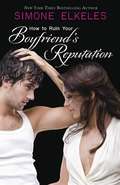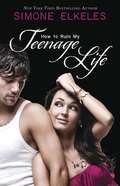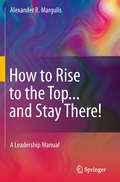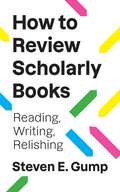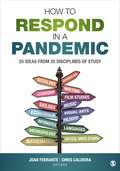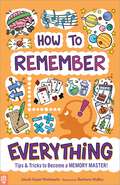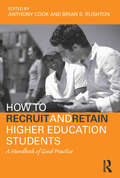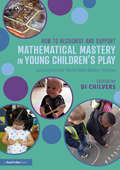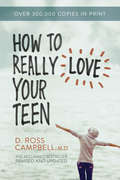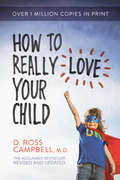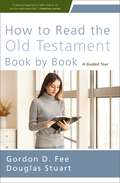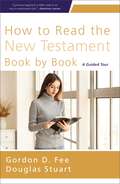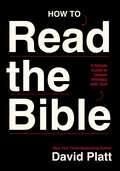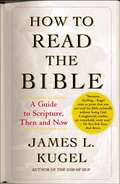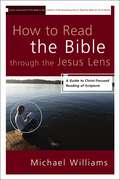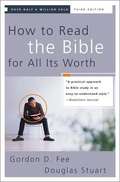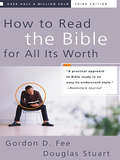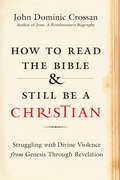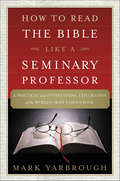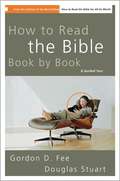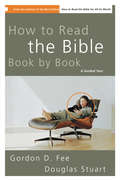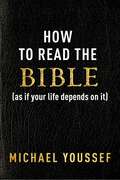- Table View
- List View
How to Ruin Your Boyfriend's Reputation (How to Ruin #3)
by Simone ElkelesIn the third book of this bestselling series, Amy Barak-Nelson misses her boyfriend Avi, who is in the Israeli army. Her grandmother convinces Amy to sign up for two weeks in a military training base. Not her idea of fun, but what's worse?
How to Ruin My Teenage Life (How to Ruin #2)
by Simone ElkelesIn this sequel to "How to Ruin a Summer Vacation", everything in 16-year-old Amy Nelson-Barak's life is going wrong. What's a girl to do when everyone is trying to ruin her life?
How to Rise to the Top...and Stay There!
by Alexander R. MargulisThe present dire economic environment has greatly affected business and the opportunities for advancement or even holding a job. Even universities, although not directly in business, are feeling the impact of diminishing endowments, resulting in lower disposable funds and reduction in innovative, unproven programs, which, in the past, often led to breakthroughs. These conditions we hope are only temporary, and they will not affect careers in the long run. This book is written to guide the reader on how to progress in his or her chosen career, how to reach a high position in which one is actually in charge of a unit, department, school, or business and how to run it successfully.
How to Review Scholarly Books: Reading, Writing, Relishing (Skills for Scholars)
by Steven E. GumpA guide to the art of reviewing scholarly books, with strategies and suggestionsScholarly book reviews should be enjoyable—both to write and to read. All too often, though, they offer little more than chapter-by-chapter summaries. In this comprehensive handbook, Steven Gump offers an encouraging guide to crafting valuable reviews of scholarly books in the humanities and social sciences. Readers learn how to write engaging, respectful reviews that make intellectual contributions of their own. With extensive experience in both writing and editing scholarly book reviews, Gump walks prospective reviewers through the process of selecting a book to review, identifying a venue to publish the review, reading and annotating the book, and writing a review that is tailored to the audience of the target venue, with the possibility of dissemination to popular outlets beyond the core field.Alongside this practical advice, Gump offers a generous philosophy of scholarly book reviewing that considers the roles of book reviews and the responsibilities of book reviewers within the broader scholarly ecosystem. Readers learn how to uplift the voices and contributions of authors, how to prepare the next generation of reviewers (including undergraduates or graduate students), and how to elevate an unjustly underestimated genre. Ultimately, this essential guide brings into renewed focus the joys of reading scholarly works, engaging with intellectual ideas, and writing incisively.
How to Respond in a Pandemic: 25 Ideas from 25 Disciplines of Study
by Joan Ferrante Chris CaldeiraHow can an undergraduate college education prepare learners to cope with the current COVID-19 pandemic? This collection of short essays, written by experts in 25 academic fields of study, addresses this very question. Each chapter brings perspective and insight from that discipline, presenting one useful idea and a recommended course of action. This one-of-a-kind resource is ideal for students, instructors, and administrators, particularly during the 2020-2021-academic year when institutions are challenged to continue their educational missions in the midst of a public health crisis that affects every aspect of college life.
How to Respond in a Pandemic: 25 Ideas from 25 Disciplines of Study
by Joan Ferrante Chris CaldeiraHow can an undergraduate college education prepare learners to cope with the current COVID-19 pandemic? This collection of short essays, written by experts in 25 academic fields of study, addresses this very question. Each chapter brings perspective and insight from that discipline, presenting one useful idea and a recommended course of action. This one-of-a-kind resource is ideal for students, instructors, and administrators, particularly during the 2020-2021-academic year when institutions are challenged to continue their educational missions in the midst of a public health crisis that affects every aspect of college life.
How to Remember Everything: Tips & Tricks to Become a Memory Master!
by Jacob Sager Weinstein Odd DotHOW TO REMEMBER EVERYTHING is the ultimate guide to unlocking the power of your brain!Kids will learn how to ace history tests by memorizing dates, feel confident about remembering people's names, win card games by mastering entire decks, and hang on to happy memories for a lifetime.This invaluable memory guide for children is full of recall-building techniques, fun challenges, and hilarious art.
How to Remember Anything: Teach Yourself
by Mark ChannonWhat would you do if you could remember anything? ""How to Remember Anything"" shows how a radically improved memory can add real value in life and in business and can help build your career and your personal life. It is full of practical techniques that will not just show you how to remember things such as numbers, dates and facts, but also real and innovative insight into new ways of learning and processing information that could completely change your life. The goal of this book is to show you how to use your new, improved memory to enhance your career, your personal life and your leisure time, and because of this it is more practical and transformational than any other 'Memory boosting' title available.
How to Recruit and Retain Higher Education Students: A Handbook of Good Practice
by Tony Cook Brian S. RushtonHow to Recruit and Retain Higher Education Students is an invaluable resource for academic staff, administrators and policy makers involved in student recruitment and improving student retention. It offers practical advice on how universities can influence the expectations of prospective students, allowing them to make sensible decisions about careers, courses and institutions. Many surveys of students who drop out of university show that most do so out of disappointment. Failing to understand what higher education was about quickly enough, they become confused and frustrated. Dropping out seems the best solution. This book describes a series of practices proven to encourage students to stay on, discussing the background research on student attrition. By preparing students better for their higher education experience, the practices in this book are effective not only in recruiting students but also in matching them to the right institutions and programmes. The practices described range from those reaching out in a broad way to communities of potential students, to university support for pre-entry examinations, to enhanced communication between institutions and applicants. All are described in sufficient detail to allow judgments to be made about how to use and adapt them to suit local needs. How to Recruit and Retain Higher Education Students provides a sound theoretical foundation for research into student retention and provides the necessary underpinning for those academic staff embarking on courses and assists in preparing them for their roles in both teaching and student support.
How to Recognise and Support Mathematical Mastery in Young Children’s Play: Learning from the 'Talk for Maths Mastery' Initiative
by Di ChilversThis exciting book explores young children’s fascination with all things mathematical. Drawing on the 'Talk for Maths Mastery' initiative, it helps practitioners to understand early mathematical development and recognise the maths taking place in children’s play. Emphasising the importance of starting from children’s existing mathematical interests, it shows how adults can build on these starting points to gradually introduce new concepts and address misconceptions as they arise. The book considers how mathematical development and learning is embedded within children’s dispositions and mindsets. Including case studies, links to practice and reflective questions, the chapters reveal what mastery orientation looks like from the children’s perspective in their learning and covers: children’s serve and return conversational talk mathematical babies and their developmental momentum schematic patterns of thinking mathematical mark-making child-led play problem solving creative and critical thinking how adults can support children’s mathematical talk, thinking and mastery Featuring children’s learning stories and full-colour photographs throughout to illustrate practice, this book is essential reading for all early years practitioners and teachers working with children throughout the EYFS and KS1 as well as students on early years courses.
How to Really Love Your Teen
by D. Ross CampbellIt's one of the most common parenting scenarios--parent and child are developing nicely, when the child crosses that mysterious threshold into the "teenager zone." Suddenly, the parents feel unable to fully relate to their teen--and the teen responds to the parents' uneasiness. In this best-selling book, Dr. Campbell helps parents understanding the delicate dance between parents and their emerging teenagers. Learn how to create a solid, balanced approach for relating to your teen, how to communicate unconditional love, how to handle teenage anger, as well as your own, and how to help your teenager grow spiritually and intellectually.
How to Really Love Your Child
by D. Ross CampbellMany parents would be dismayed to discover that their child feels unloved. After all, they make sure that their child has the things they need. They attend their child's school events. They buy their child the things they want. So why is it then that most children doubt that they are genuinely and unconditionally loved? In this best-selling book, Dr. D. Ross Campbell reveals the emotional needs of a child and provides parents with the skill and techniques that can begin to help make your child feel truly loved and accepted. You'll learn to really love your child through every situation of child rearing from physical touch to discipline and from affirmation to spiritual nurture.
How to Read the Old Testament Book by Book: A Guided Tour
by Douglas Stuart Gordon D. FeeReading the Old Testament doesn't need to be a difficult journey through strange and bewildering territory. How to Read the Old Testament Book by Book walks you through the Scriptures like an experienced tour guide, helping you understand each of its thirty-nine books.For each book of the Old Testament, the authors start with a quick snapshot, then expand the view to help you better understand its message and how it fits into the grand narrative of the Bible. Written by two top evangelical scholars, this survey is designed to get you actually reading the Bible knowledgeably and understanding it accurately.In an engaging, conversational style, Gordon Fee and Douglas Stuart take you through every book of the Old Testament using their unique approach:Orienting Data - Concise info bytes that form a thumbnail of the book.Overview - A brief panorama that introduces key concepts and themes and important landmarks in the book.Specific Advice for Reading - Pointers for accurately understanding the details and message of the book in context with the circumstances surrounding its writing.A Walk Through - The actual section-by-section tour that helps you see both the larger landscape of the book and how its various parts work together to form the whole.How to Read the Old Testament Book by Book can be used as a companion to How to Read the New Testament Book by Book and How to Read the Bible for All Its Worth. It also stands on its own as a reliable guide to reading and understanding the Old Testament for yourself.
How to Read the New Testament Book by Book: A Guided Tour
by Douglas Stuart Gordon D. FeeReading the New Testament doesn't need to be a difficult journey through strange and bewildering territory. How to Read the New Testament Book by Book walks you through the Scriptures like an experienced tour guide, helping you understand each of its twenty-seven books.For each book of the New Testament, the authors start with a quick snapshot, then expand the view to help you better understand its message and how it fits into the grand narrative of the Bible. Written by two top evangelical scholars, this survey is designed to get you actually reading the Bible knowledgeably and understanding it accurately.In an engaging, conversational style, Gordon Fee and Douglas Stuart take you through every book of the Old Testament using their unique approach:Orienting Data - Concise info bytes that form a thumbnail of the book.Overview - A brief panorama that introduces key concepts and themes and important landmarks in the book.Specific Advice for Reading - Pointers for accurately understanding the details and message of the book in context with the circumstances surrounding its writing.A Walk Through - The actual section-by-section tour that helps you see both the larger landscape of the book and how its various parts work together to form the whole.How to Read the New Testament Book by Book can be used as a companion to How to Read the Old Testament Book by Book and How to Read the Bible for All Its Worth. It also stands on its own as a reliable guide to reading and understanding the New Testament for yourself.
How to Read the Bible: A Simple Guide to Deeper Intimacy with God
by David PlattThis simple and practical guide to studying and understanding Scripture will help you see the Bible as a priceless treasure that reveals God's love for you and His relentless pursuit of a deeper relationship.How to Read the Bible is not just a book; it's an invitation to experience God's Word in a way that transforms your life. Whether you're new to reading the Bible or seeking a fresh approach to study and apply it, this guide provides the tools and insights you need to explore Scripture with greater clarity and purpose.David Platt, author of the bestseller Radical and host of Secret Church (an annual event streamed to participants around the world), shows you how to read, study, and understand the Bible in such a way that you fall deeper in love with its Author. His four-step guide to studying God's Word rightly is set up with the acrostic MAPS:Meditate on and memorize God's Word, storing it in your heart and mind so that you walk closer with Jesus each day.Apply the Bible's truths to every layer of your life, allowing the Holy Spirit to transform you and revolutionize your ultimate purpose for living.Pray boldly, confident that God will answer and align your heart with His Word.Share God's Word with others, letting it flow through you to your neighbor as well as to others around the world. Each chapter includes interactive questions for self-reflection or group discussion, and an appendix that offers practical tips for reading different parts of the Bible (Law, Poetry, Gospels, Revelation, etc.).As you dive into the richness of the Bible using this proven, step-by-step approach, you will learn to avoid common pitfalls in interpretation, savor scriptures through meditation and prayer, and apply timeless truths to every area of your life. How to Read the Bible equips you to better understand not only the Word of God but also the love of God and His plan for the world.
How to Read the Bible: A Guide to Scripture, Then and Now
by James L. KugelJames Kugel&’s essential introduction and companion to the Bible combines modern scholarship with the wisdom of ancient interpreters for the entire Hebrew Bible.As soon as it appeared, How to Read the Bible was recognized as a masterwork, &“awesome, thrilling&” (The New York Times), &“wonderfully interesting, extremely well presented&” (The Washington Post), and &“a tour de force...a stunning narrative&” (Publishers Weekly). Now, this classic remains the clearest, most inviting and readable guide to the Hebrew Bible around—and a profound meditation on the effect that modern biblical scholarship has had on traditional belief. Moving chapter by chapter, Harvard professor James Kugel covers the Bible&’s most significant stories—the Creation of the world, Adam and Eve, Cain and Abel, Noah and the flood, Abraham and Sarah, Jacob and his wives, Moses and the exodus, David&’s mighty kingdom, plus the writings of Isaiah, Jeremiah, and the other prophets, and on to the Babylonian conquest and the eventual return to Zion. Throughout, Kugel contrasts the way modern scholars understand these events with the way Christians and Jews have traditionally understood them. The latter is not, Kugel shows, a naïve reading; rather, it is the product of a school of sophisticated interpreters who flourished toward the end of the biblical period. These highly ideological readers sought to put their own spin on texts that had been around for centuries, utterly transforming them in the process. Their interpretations became what the Bible meant for centuries and centuries—until modern scholarship came along. The question that this book ultimately asks is: What now? As one reviewer wrote, Kugel&’s answer provides &“a contemporary model of how to read Sacred Scripture amidst the oppositional pulls of modern scholarship and tradition.&”
How to Read the Bible through the Jesus Lens: A Guide to Christ-Focused Reading of Scripture
by Michael WilliamsHow to Read the Bible through the Jesus Lens connects each of the sixty-six books of the Bible to the person and work of Jesus Christ. By explaining each book’s theme and raising pertinent questions about the contemporary importance of that message, author Michael Williams sets readers on a path toward purposeful, independent reading and application of the entire Bible.
How to Read the Bible for All Its Worth: Fourth Edition
by Douglas Stuart Gordon D. FeeUnderstanding the Bible isn’t for the few, the gifted, the scholarly. The Bible is accessible. It’s meant to be read and comprehended by everyone from armchair readers to seminary students. A few essential insights into the Bible can clear up a lot of misconceptions and help you grasp the meaning of Scripture and its application to your twenty-first-century life. More than three quarters of a million people have turned to How to Read the Bible for All Its Worth to inform their reading of the Bible. This fourth edition features revisions that keep pace with current scholarship, resources, and culture. Changes include: Updated language for better readability Scripture references now appear only in brackets at the end of a sentence or paragraph, helping you read the Bible as you would read any book—without the numbers A new authors’ preface Redesigned and updated diagrams Updated list of recommended commentaries and resources Covering everything from translational concerns to different genres of biblical writing, How to Read the Bible for All Its Worth is used all around the world. In clear, simple language, it helps you accurately understand the different parts of the Bible—their meaning for ancient audiences and their implications for you today—so you can uncover the inexhaustible worth that is in God’s Word.
How to Read the Bible for All Its Worth
by Douglas Stuart Gordon D. FeeBoth teachers and students of the Bible will find this book to be a handy reference. As the authors show how to employ different (but traditional) methods for considering the various types of sacred writings represented in the Bible.
How to Read the Bible for All Its Worth
by Douglas Stuart Gordon D. FeeYour Guide to Understanding the Bible Understanding the Bible isn’t for the few, the gifted, the scholarly. The Bible is accessible. It’s meant to be read and comprehended by everyone from armchair readers to seminary students. A few essential insights into the Bible can clear up a lot of misconceptions and help you grasp the meaning of Scripture and its application to your 21st-century life. More than half a million people have turned to How to Read the Bible for All Its Worth to inform their reading of the Bible. This third edition features substantial revisions that keep pace with current scholarship, resources, and culture. Changes include: •Updated language •A new authors’ preface •Several chapters rewritten for better readability •Updated list of recommended commentaries and resources Covering everything from translational concerns to different genres of biblical writing, How to Read the Bible for All Its Worth is used all around the world. In clear, simple language, it helps you accurately understand the different parts of the Bible—their meaning for ancient audiences and their implications for you today—so you can uncover the inexhaustible worth that is in God’s Word.
How to Read the Bible and Still Be a Christian
by John Dominic CrossanThe Bible introduces us to a loving Jesus who turns the other cheek, loves his enemies, and shows grace to all. But we also meet a warrior Jesus who leads an army of angels bent on earthly destruction. Which is the true Messiah? Should we all follow the nonviolent Jesus of the Sermon on the Mount or the vengeful, sword-wielding Christ of Revelation? As one of the foremost biblical scholars of our day, John Dominic Crossan re-veals that running throughout the entire Bible--from Genesis to Revelation--are two conflicting revelations of God: one offering a radical, holy vision where every need is provided for and love and grace are extended widely; the other working to domesticate this radical vision by em-phasizing judgment and punishment and by propping up the status quo. But one thing is clear, argues Crossan: one cannot pretend that the Bible provides a single, unified vision of God or Jesus. If one wants to discover the Bible's best and purest revelation of God, then Christians must measure the Bible by Jesus. And to find the best and purest revelation of Jesus, Crossan concludes, then we must look to the work of scholars who can point us to the teachings of the historical Jesus. Only then will we know how to read the Bible and still be a Christian.
How to Read the Bible Like a Seminary Professor: A Practical and Entertaining Exploration of the World's Most Famous Book
by Mark YarbroughMany people admire and even revere the Bible, but they simply do not understand what they read, much less how to study Scripture. Yet they wish they could. In this insightful and alternately amusing guide, Professor Mark Yarbrough shows how easy and gratifying it is to unlock the hidden truths of God's Word and to discover a world where reading the Bible doesn't just satisfy our curiosity, but changes our life. To do this, the reader will step into the seminary classroom and observe the practical principles-the tricks of the trade-for becoming a more effective student of the Bible. But Yarbrough has made sure that his writing style and general approach will be appealing to both academic students and those involved in lay-level Bible study. Real life is whacky and in-your-face. Studying Scripture should be too.
How to Read the Bible Book by Book: A Guided Tour
by Douglas Stuart Gordon D. FeeA Guided Tour from Genesis through Revelation. Reading the Bible need not be a haphazard journey through strange and bewildering territory. Like an experienced tour guide, How to Read the Bible Book by Book takes you by the hand and walks you through the Scriptures. For each book of the Bible, the authors start with a quick snapshot, then expand the view to help you better understand its key elements and how it fits into the grand narrative of the Bible. Written by two top evangelical scholars, this survey is designed to get you actually reading the Bible knowledgeably and understanding it accurately. In an engaging, conversational style, Gordon Fee and Douglas Stuart take you through a given book of the Bible using their unique, progressive approach-- Orienting Data: Concise info bytes that form a thumbnail of the book; Overview: A brief panorama that introduces key concepts and themes and important landmarks in the book; Specific Advice for Reading: Pointers for accurately understanding the details and message of the book in context with the circumstances surrounding its writing; A Walk Through: The actual section-by-section tour that helps you see both the larger landscape of the book and how its various parts work together to form the whole. Here you are taken by the hand and told, "Look at this!" How to Read the Bible Book by Book can be used as a companion to How to Read the Bible for All Its Worth. It also stands on its own as a reliable guide to reading and understanding the Bible for yourself.
How to Read the Bible Book by Book: A Guided Tour
by Gordon D. FeeA Guided Tour from Genesis through Revelation Reading the Bible need not be a haphazard journey through strange and bewildering territory. Like an experienced tour guide, How to Read the Bible Book by Book takes you by the hand and walks you through the Scriptures. For each book of the Bible, the authors start with a quick snapshot, then expand the view to help you better understand its key elements and how it fits into the grand narrative of the Bible. Written by two top evangelical scholars, this survey is designed to get you actually reading the Bible knowledgeably and understanding it accurately. In an engaging, conversational style, Gordon Fee and Douglas Stuart take you through a given book of the Bible using their unique, progressive approach: • Orienting Data—Concise info bytes that form a thumbnail of the book • Overview—A brief panorama that introduces key concepts and themes and important landmarks in the book • Specific Advice for Reading—Pointers for accurately understanding the details and message of the book in context with the circumstances surrounding its writing • A Walk Through—The actual section-by-section tour that helps you see both the larger landscape of the book and how its various parts work together to form the whole. Here you are taken by the hand and told, “Look at this!” How to Read the Bible Book by Book can be used as a companion to How to Read the Bible for All Its Worth. It also stands on its own as a reliable guide to reading and understanding the Bible for yourself.
How to Read the Bible (as If Your Life Depends on It)
by Michael YoussefAs fewer Christians read the Bible daily, fewer understand what a marvelous revelation it is from God to man. How to Read the Bible (as If Your Life Depends on It) offers believers and nonbelievers alike a new appreciation for the Bible, helping them to read it for understanding, not just as the storybook they remember from childhood.There is no other book like the Bible. God used at least forty human writers over more than 1,600 years to compost the sixty-six books of the Old and New Testaments.They included kings and shepherds, a physician and a tax collector. They lived on three continents—Europe, Asia, and Africa. Yet the Bible is a single Book with a single Author, focused on a single theme: Jesus the Messiah, our Redeemer. From beginning to end, the Bible tells the story of the Kingdom of God and its King. The Old Testament tells us He is coming. The New Testament announces that He has arrived. The sixty-six books of the Bible do not tell sixty-six stories. Together they tell one story. It&’s the story of humanity&’s rebellion against God and God&’s redemptive love for the human race. It&’s the story of a Kingdom and a Covenant, of one Lord who saves completely and rules eternally. The unity of the Bible confounds human wisdom. The unity of the Bible baffles its critics. The unity of the Bible challenges its enemies. There&’s no book like this Book because there&’s no author like its Author.
